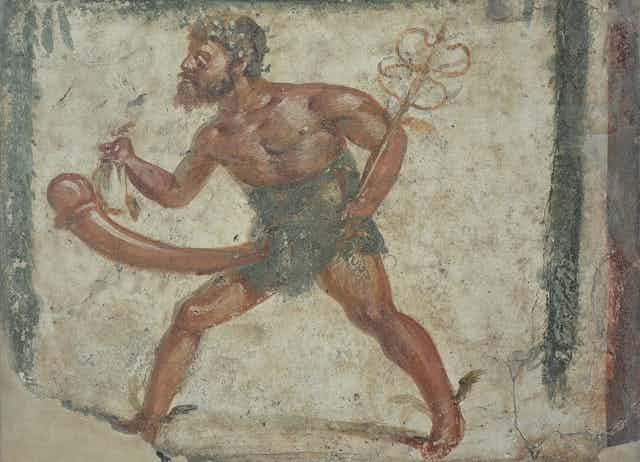WARNING: This article contains graphic language of a violent sexual nature.
Deep in the dank, dark anonymity of cyberspace dwell trolls – fearsome online guardians of digital values – ever vigilant, never sleeping. When called to arms, they mobilise with swift and deadly efficiency against anyone crossing bridges to trespass on hallowed ground.
Despite the archaic tag, they are often seen as an unsavoury but inescapable consequence of modern online life – a squalid byproduct of the 24-hour news cycle and the ever escalating appetite for online titillation.
We tend to see this sort of abuse as quintessentially modern but it may surprise you to learn that these violent, sexualised responses to perceived boundary violations are nothing new. They would be instantly familiar to ancient Romans, as their threatening tone, graphic language and malicious intent are strikingly similar to those associated with the rustic fertility god Priapus.
Weapons of choice in this – mostly online – “war on error” habitually include graphic threats of rape and brutal sexual violence. When cornered, these trolls often radiate astonishment that their threats were taken seriously.
They claim they were merely exercising their right to free speech, that they were obviously only joking – and anyway, their targets should just toughen up.
The majority of targets of such highly-sexualised harassment are female. Recent examples include the ongoing strident crusade against feminist media critic Anita Sarkeesian, initially over her campaign to crowdsource funding for videos that critique the ingrained sexism within the gaming industry.
And then there’s the vicious campaign waged against the feminist activist and journalist Caroline Criado-Perez for her suggestion that female faces were underrepresented on British banknotes; or even the umbrage taken at Richard Glover’s musings on the methodology of climate change sceptics.
As a recent Conversation article observed, euphemisms such as “unpleasant” or “sexually explicit” just don’t cut it when it comes to conveying the violence and vitriol of these outbursts.
If we don’t say it like it is, we run the risk of undermining our perception of the serious effect these attacks have on the victims.
And so, to the past.

Within the Roman Empire, statues of Priapus were often placed in gardens and orchards to act as scarecrows or guardians, routinely accompanied by warnings of sexual violence against thieves and trespassers of either sex.
Priapus is thought to have begun life in the Greek colonies of Asia Minor. Our earliest record of him comes from a play by the Greek author Xenarchus in the 4th century BC and references become more common as his worship spreads throughout Greece and on to Italy.
By the time he was absorbed into the Roman pantheon, Priapus, like many Roman gods, had quite an extensive portfolio. Among his responsibilities were human sexuality, the fertility and abundance of livestock, gardens, orchards, grapevines and bees as well as the protection of sailors and boundaries.
He commonly featured in Roman erotic art and literature, especially a series of short, obscene, anonymous verses collectively known as the Priapea.
Although often portrayed as a comic figure, as a guardian of boundaries, Priapus represented the distillation of masculine sexual aggression, dominance and power – the embodiment of rape.
So, we have brutal sexual threats against perceived trespassers, made anonymously, with the expectation that they will be seen as “humorous”. Sound familiar?
Ancient Rome was undoubtedly a man’s world and the masculine drive to conquer and dominate drove the voracious expansion of the Empire. Roman attitudes to sex and sexuality were similarly male-centric and, to our modern western sensibilities, quite alien.
For male citizens (it was a very different situation for slaves and women), when it came to sex, pretty much the only requirement was that they remain the “active” partner. In this context, threatening to rape another man who had “crossed a line” was seen as a display of male dominance rather than an expression of homosexuality.
Let’s start with an ancient, anonymous all-purpose threat against trespassers from the Priapea:
I give fair warning: a boy – I’ll bugger, a girl – I’ll fuck: the third penalty [(i.e. oral rape)] remains for the bearded thief.
(Priapea 13, translated by M. Johnson and T. Ryan)
The Roman poet Catullus is probably best known for his tender love poems but he wasn’t afraid to let fly in Priapic style when someone “went there” and questioned his masculinity:
You, who read [of] all these thousand kisses,
you think I’m less of a man?
I’ll rape your mouth, and I’ll bugger you.(Catullus 16 adapted from A.Kline’s translation)
Finally, these modern gems:
SHUT YOUR WHORE MOUTH … OR ILL SHUT IT FOR YOU AND CHOKE IT WITH MY DICK.
You just don’t know when to shut up …. go put a dick in your mouth and shut up.
I don’t advocate violence against women but this bitch I’ll make an exception for (WITH MY DICK).
All of the writers, ancient and modern, clearly believe that some sort of line has been crossed. All radiate righteous wrath, advocating sexual violence to “correct” this transgression or (in some cases literally) to silence unwelcome criticism.
Some of our modern boundaries may no longer be tangible and literal but the triggers – the aggressively masculine voice, anonymity and highly violent, sexualised threats – remain uncannily consistent over time.
Although he may be posing as a troll, it looks like the ancient god Priapus – or at least his voice – is alive and well and thriving in cyberspace.
This article is part of The Conversation’s Religion + Mythology series.

